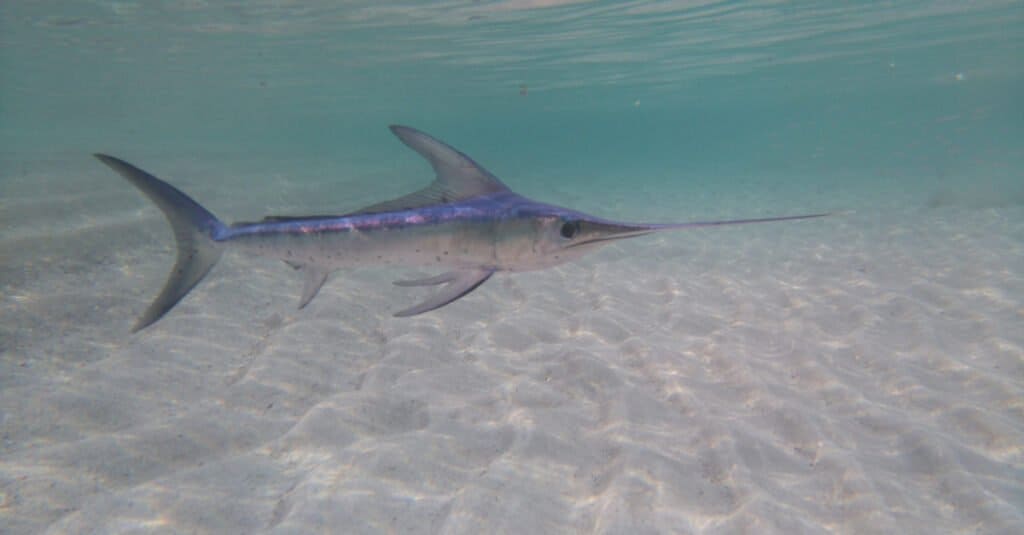Swordfish
Xiphias gladius
Lose their scales and teeth as adults
Advertisement
Swordfish Scientific Classification
- Kingdom
- Animalia
- Phylum
- Chordata
- Class
- Actinopterygii
- Order
- Istiophoriformes
- Family
- Xiphiidae
- Genus
- Xiphias
- Scientific Name
- Xiphias gladius
Read our Complete Guide to Classification of Animals.
Swordfish Conservation Status
Swordfish Facts
- Prey
- Fish, squid, crustaceans
- Main Prey
- Fish
- Name Of Young
- Larva
- Group Behavior
- Solitary
- Fun Fact
- Lose their scales and teeth as adults
- Estimated Population Size
- Millions
- Biggest Threat
- Fishing
- Most Distinctive Feature
- Long, flat rostrum
- Distinctive Feature
- Lack scales and teeth
- Other Name(s)
- Broadbills
- Average Spawn Size
- 1 million to 30 million
- Habitat
- Pelagic water
- Predators
- Orca, sharks, marlins, sailfish
- Diet
- Carnivore
- Lifestyle
- Solitary
- Favorite Food
- Fish
- Common Name
- Swordfish
- Special Features
- Specialized tissue behind eyes that protects against temperature changes
- Number Of Species
- 1
- Location
- Pacific, Indian, and Atlantic Oceans
- Migratory
- 1
Swordfish Physical Characteristics
- Color
- Grey
- White
- Silver
- Light Grey
- Dark Grey
- Skin Type
- Smooth
- Top Speed
- 60 mph
- Lifespan
- 4-15 years
- Weight
- 150-1430 pounds
- Length
- 9-15 feet
- Age of Sexual Maturity
- 4-5 years
- Age of Weaning
- Hatching
- Venomous
- No
- Aggression
- Medium
View all of the Swordfish images!
Summary
One of the fastest fish in the ocean, the swordfish is the sole member of the family Xiphiidae. A close relative of the sailfish and marlin, swordfish are popular sport fish thanks to their powerful bodies and speed. They are highly migratory and can tolerate rapid temperature changes thanks to specialized tissue behind their eyes that acts as a space heater. Swordfish use their long, pointed bills to help them cut through the water and to defend themselves from other predators.
5 Swordfish Facts
- Swordfish possess a specialized tissue behind their eyes that produces its own heat to help protect their eyes and brain from rapid temperature changes.
- At top speed, it can swim up to 60 miles per hour.
- The world record for the largest swordfish ever caught belongs to a 1,182-pound specimen caught in 1953 off the coast of Chile.
- A single female can lay anywhere from 1 million to 30 million eggs at one time.
- Swordfish use their rostrum to knock prey off balance and defend themselves from other predators.
Swordfish Classification and Scientific name
Also known as broadbills, they get their common name from their long, sword-shaped bill. They are the sole members of the family Xiphiidae and genus Xiphias. Their species name, Xiphias gladius, stems from two different languages. In Greek, Xiphias translates as swordfish, which in turn stems from the word xiphos, or “sword.” Meanwhile, gladius derives from the Latin word for “sword.”
Swordfish Appearance

The swordfish is named after its sword-like bill. They rely on their speed and agility to catch their prey.
©SVITO-Time/Shutterstock.com
Swordfish are among the most recognizable fish in the world. They possess long, round bodies that appear bright silver, although they are actually slightly darker on top and lighter on the bottom. This coloration acts as a form of natural camouflage, as they blend in with light to fish below them and dark to fish above them. While they are born with scales and teeth, they lose these features by the time they reach adulthood. Mature fish commonly measure around 10 feet long and weigh between 150 and 250 pounds. However, they can grow up to a maximum size of almost 15 feet long and 1430 pounds.
The most characteristic feature of this fish has to be its bill, also known as a rostrum. The rostrum measures nearly one-third of the length of the body and has a rough surface. In addition to serving as a weapon, it primarily helps them with navigation, as it creates a slipstream that enables them to cut through the water more efficiently.
Swordfish Behavior
For the most part, they do not swim in schools. They typically swim alone, although they may travel in loose formations. Swordfish like to spend time near the surface not just to eat but also to rest and air their large dorsal fin. Occasionally, they will jump from the water, often to dislodge external parasites such as remoras and lampreys. They use their elongated, flattened rostrum most often not to hunt but for defense. When threatened, they may use their rostrum to stab potential attackers, as evidenced by the bodies of sharks discovered by fishers with broken swordfish rostrums in their bodies.
Swordfish Distribution, Population, and Habitat
These fish are pelagic, meaning that they typically live in open water. They prefer temperate and tropical regions where the water ranges between 64 and 72 degrees Fahrenheit. That said, they can tolerate temperatures from 41 to 81 degrees Fahrenheit. Swordfish migrate long distances, moving to colder regions to feed during the summer and warmer regions during the winter. During the day, they range from surface level to depths of nearly 9,442 feet below sea level.
You can find them around the world except for extremely cold regions such as the Arctic or Southern Oceans. Their range extends throughout the tropical and temperate parts of the Pacific, Atlantic, and Indian Oceans. In the Atlantic, swordfish are distributed between Newfoundland and southern Brazil. Meanwhile, in the Pacific, their range extends as far as northern Japan and the southern tip of New Zealand.
While the fish stocks in the Pacific and Indian Oceans are either wavering or on the decline, swordfish in the Atlantic are thriving. Commercial fisheries harvest more than 2 million pounds of swordfish annually from the North Atlantic, equating to over 13,000 fish. Given that these stocks are stable despite this haul, it’s safe to assume that the adults in the Atlantic alone number in the hundreds of thousands. Meanwhile, the worldwide population probably measures in the millions.
Swordfish Predators and Prey
Generally speaking, adults have no natural predators aside from orcas and humans. That said, some larger predators will occasionally try to take on a swordfish. Shortfin mako often try to prey on swordfish, but swordfish are usually more than a match for these speedy sharks. On the other hand, juvenile swordfish lack the speed and strength of adults. Several predatory fish target juvenile swordfish, including sharks, tuna, marlins, and sailfish.
In addition to predators, they must also contend with a host of nasty parasites. Scientists have documented almost 50 different parasites in swordfish. These parasites include parasitic fish such as remoras and lampreys as well as tiny invertebrates like tapeworms, roundworms, and copepods.
Swordfish are very near apex predators that eat a wide nearly anything they can catch. They typically feed at night close to the surface when smaller fish are most abundant. Their diet consists of various fish, including mackerel, rockfish, herring, and lanternfish, as well as squid and crustaceans. Contrary to popular belief, swordfish do not use their rostrum to spear their prey. That said, they may occasionally use it to weaken their prey with slashes or blows. They mostly rely on their strength and speed when hunting. They can swim up to 60 miles per hour, and often consume their prey whole, as they lack teeth.
Swordfish Reproduction and Lifespan
Swordfish spawn at different times of the year depending on the region. While most populations spawn in the spring or summer, others – such as those in the equatorial Pacific – spawn year-round. Female swordfish carry prodigious numbers of eggs, with the largest females carrying the most eggs. They can carry anywhere from 1 million to 30 million eggs, each measuring less than 2 millimeters in diameter. Even after hatching, larva measure little more than 4 millimeters long.
Generally speaking, swordfish mature between 4 and 5 years of age. They can live up to 15 years, although most tend to be between 9 and 11 years. It is rather difficult to age them because they possess small otoliths, calcium structures in the ear that scientists usually use to date fish. To date swordfish, scientists must instead count the annual rings of the fin rays.
Swordfish in Fishing and Cooking:
In recent years, the popularity of swordfish in cooking has fallen off due to restrictions on fishing and coordinated conservation campaigns. However, many people around the world still eat swordfish regularly. Swordfish is incredibly meaty and typically served in “steak” forms. This makes it ideal for cooking on a grill or on skewers, as the meat retains its texture well under high heat. In addition, many people enjoy cooking in stews or baking it in the oven. It’s meat has a mild, slightly sweet taste and pairs well with many kinds of sauces and marinades. That said, due to its high mercury content, health authorities encourage people not to eat too much, especially young or pregnant people.
Swordfish Conservation:
During the middle of the 20th century, the populations experienced significant declines. Between 1960 and 1998, swordfish stocks in the Atlantic declined by nearly 68 percent, as did the average size of caught fish. In response, they came under increased scrutiny by conservation groups toward the end of the 20th century. These groups began coordinated advertising efforts, such as the 1998 “Give Swordfish a Break” campaign. The efforts of these groups put pressure on governments to protect swordfish and to encourage restaurants to stop serving swordfish dishes.
Thanks to these efforts, many restaurants stopped serving swordfish, and sales in supermarkets also fell. The United States government also sectioned off 100,000 square miles in the Atlantic that was made off-limits to fishers for swordfish. As a result, North Atlantic swordfish populations have returned to their standard levels. However, the picture looks less promising in other regions. Not enough data exists on the South Atlantic or northwestern Pacific stock. In addition, evidence suggests that swordfish in the Indian Ocean and southwestern Pacific are likely on the decline. Therefore, the official assessment of swordfish by the IUCN is mixed, with some populations listed as Least Concern while others are listed as Near Threatened.
Related Animals:
- Black Marlin
- Sailfish vs Swordfish: Five Main Differences Explained
- Discover the Largest Marlin Ever Caught
Swordfish FAQs (Frequently Asked Questions)
Are swordfish carnivores, herbivores, or omnivores?
Swordfish are carnivorous and eat a wide range of fish, including mackerel, rockfish, herring, cod, silver hake, and lanternfish. They also commonly eat squid and crustaceans.
Is swordfish a good fish to eat?
Like other large predators, swordfish contain high levels of mercury, so you should not consume swordfish in high quantities. That said, swordfish possess a mild taste and meaty texture, which makes it appealing to some people who don’t usually enjoy eating fish.
What do swordfish get eaten by?
Adult swordfish have few natural predators except for orcas and humans. Juvenile swordfish are frequently eaten by sharks, marlins, tuna, and sailfish.
Do swordfish have worms?
Swordfish are very susceptible to parasites and often serve as hosts for worms, Myxozoans, and copepods. In total, scientists have identified around 50 different parasites in swordfish.
Where are swordfish found?
You can find swordfish in pelagic water throughout the Indian, Pacific, and Atlantic Oceans.
Thank you for reading! Have some feedback for us? Contact the AZ Animals editorial team.


















